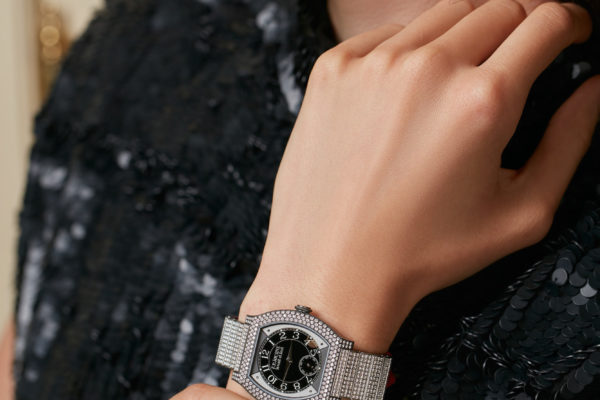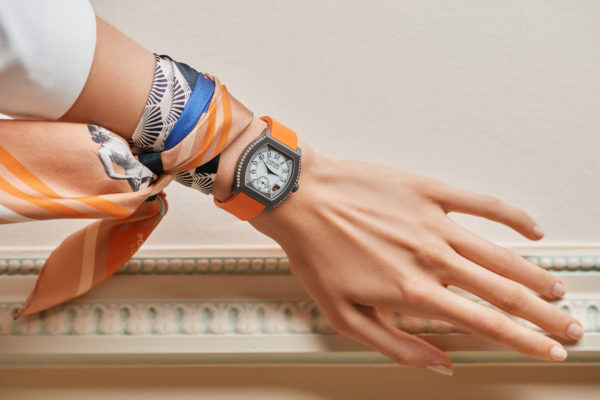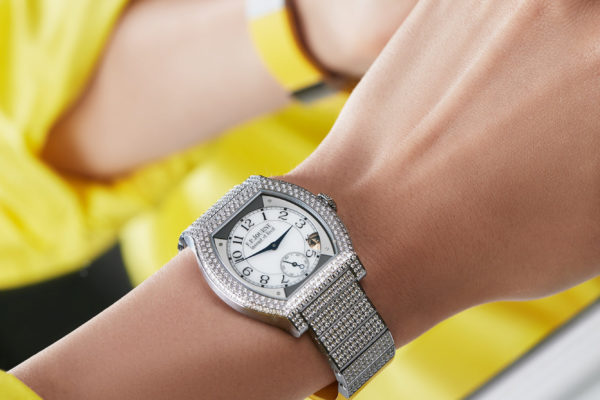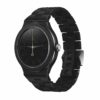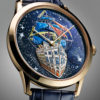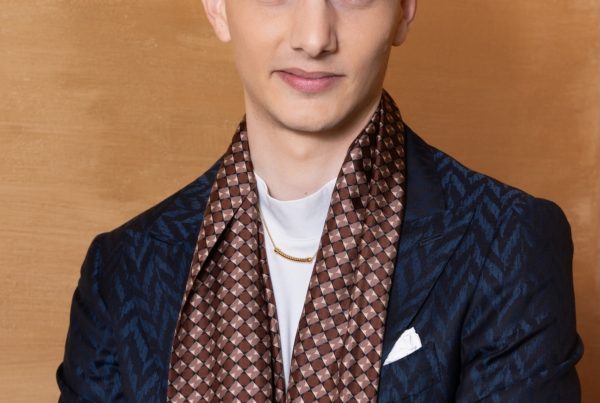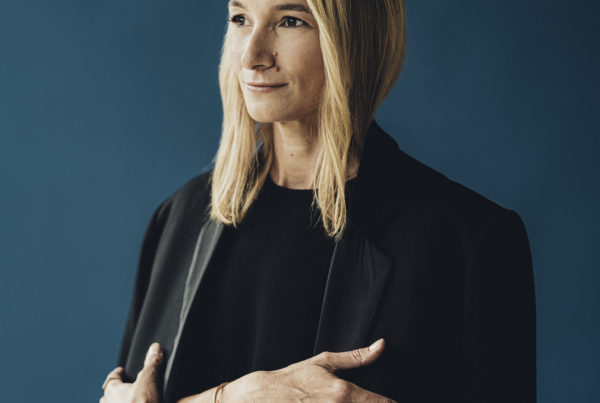Gino’s Dream, the tribute watch by François-Paul Journe
To celebrate the tenth anniversary of the élégante, his first watch with an electromechanical movement, François-Paul Journe has given it a bezel in rainbow colours. He named it Gino’s Dream, in tribute to his friend Serge Cukrowicz, alias Gino, one of his first partners. It’s the perfect opportunity to talk to the master watchmaker about the genesis of the brand and to discover some previously unpublished anecdotes. Isabelle Cerboneschi
To celebrate the tenth anniversary of the élégante, his first watch with an electromechanical movement, François-Paul Journe has given it a bezel in rainbow colours. He named it Gino’s Dream, in tribute to his friend Serge Cukrowicz, alias Gino, one of his first partners. It’s the perfect opportunity to talk to the master watchmaker about the genesis of the brand and to discover some previously unpublished anecdotes. Isabelle Cerboneschi
Serge Cukrowicz, known as Gino, may be an unfamiliar name to the uninitiated, but to connoisseurs of fine watchmaking, he was one of the most flamboyant figures in the profession. Born in Antwerp in 1959 into a family of diamond dealers and passionate about the art of watchmaking, this retailer, who died in 2021, co-founded Ginotti Jewellers in 1987. A few years later, in 1999, he threw himself passionately into the adventure of Montres Journe S.A, of which he was one of the first partners. As well as fine mechanical timepieces, he was fond of diamonds, good food and multicoloured suits. He would certainly have loved the elegant Gino’s Dream, named in his honour by his friend François-Paul Journe.
An appointment was therefore made with the master watchmaker to talk about this model set with ceramic glass stones in candy cane colours and the origins of the élégante, his first timepiece to feature an electromechanical movement. The watch is unique in that it stops after 35 minutes of immobility and resumes the flow of the hours as soon as it is put back on the wrist. But this conversation, which could have remained light-hearted, took us much further, to the true genesis of the F.P.Journe brand. This interview is full of anecdotes, laughter and emotion, and above all, it’s about friendship and all that the word can mean.
INTERVIEW
The élégante watch is celebrating its tenth anniversary this year. When you created it, did you expect it to be such a success?
François-Paul Journe : Not at all. I thought it would sell because it was better than what was available on the market, but that didn’t mean it would fetch such incredible prices at auction! I didn’t want to make many of them because we don’t have the capacity to make thousands. I wanted to sell this model to an informed public, but I didn’t think it would generate such a craze.
You originally created it because your customers’ wives were complaining that you couldn’t find watches designed for them in your collection. How did you come up with the idea of a quartz movement that suspends time when the watch is not in use?
I had already created a women’s watch, the Divine, in a 36mm gold or platinum case with a gold movement. It had its audience, but it was only for a few people because it was heavy: it weighed easily 150 grams. Yet women preferred to wear something lighter on their wrist and less restrictive than a mechanical watch. There have been very few fundamental inventions in watchmaking since the early 19th century. The first was by Charles Edouard Guillaume, who invented invar, making it possible to manufacture much more precise balance wheels and balance springs. The second major invention was quartz. Its problem is that it was ill-treated and used to make low-end watches in the 1970s. Around 98% of ladies’ watches today are quartz, but it’s poor quartz: when people feel like wearing their watch after not using it for a while, the battery is often discharged.
I started to draw up a set of specifications to fill these gaps, and that’s how I came up with this movement. It took us eight years to develop it. Fortunately, because if we had launched it when I first had the idea, perhaps the watch wouldn’t have been such a success. When the model was presented, it was a bit of a precursor, but it slowly took hold over the first five years. Then customers asked me for larger models for men. And the men’s model, which was supposed to be an outsider, became more in demand than the women’s model.
In ten years, you’ve offered the élégante a very varied wardrobe: different colours of bracelets, diamonds, different materials such as titanium, platinum, Titalyt®… Is this the model with which you feel most comfortable expressing different messages and metamorphoses?
When we first presented it, we were entering the unknown. We therefore created several models in different colours and materials, in gold, platinum, set, un-set, and then I opted for titanium. This was both for reasons of lightness and also because there was no justification for dressing up a quartz movement, however sophisticated, with materials that were too expensive. So we stopped making this watch out of precious metal. By offering a more austere range, we can offer more variety by concentrating on bracelets.
To celebrate its 10th anniversary, you’ve given it a rainbow look. Why did you choose to set the bezel with ceramic glass baguettes rather than coloured sapphires?
For the same reasons as above: you would have had to find calibrated stones, but why add value to this movement? The preciousness of this watch, its added value, is the work that it has generated. I’ll draw a parallel with Harry Winston, for whom I created the Opus One in 2001. At the time, it was an independent, family-run brand that used only materials found in nature: gold, precious stones and so on. But if you take the élégante, everything is made by human hands, including the stones.
Yet there is an élégante in Titanium/Titalyt® set with diamonds?
Yes, but the brilliants used in watchmaking don’t cost a fortune: they’re the most common in the world.
Can these ceramic glass baguettes be set like precious stones?
Not at all. On one side they fit into a rail and on the other side they are held in place by two small nails. It’s very difficult to set titanium and our teams had to invent a system to do it.
How did you come up with this multicoloured piece called Gino’s Dream?
A customer in Los Angeles wanted me to make him an élégante set with emeralds. I refused because the price would have been too high. I thought of an alternative: ceramic glass baguettes. I created a prototype with the bezel in ruby and another in emerald, but I wasn’t happy with it because with monochrome bezels you can’t have fun changing the colour of the bracelets, whereas with a rainbow, all the bracelets are compatible. The final prototype was ready last year. I showed it to Shawn Mehta, Gino’s son, who runs our London boutique, and he said, “Gino would have liked that one! So I decided to call it Gino’s Dream. It was a no-brainer: if he’d been there, he would have left with it.
The colours seem to have been inspired by the suits he wore.
He’d find a new one for every event! He would prepare his appearance. When I first met him, 35 years ago, his favourite colour was yellow. He had a canary yellow suit, a canary yellow car and everything in yellow (laughs). Later on, he improved his style by colouring things up.
How did you meet Gino?
It was at the Basel Fair in the 1990s. At the end of the day, around 6pm, Georges Daniels always wanted us to have a drink together. We’d head over to Daniel Roth’s booth, where there was a whole crowd of people who worked with Daniel and his clients, including Gino. Over dinner, Gino asked me to explain the watch I had on my wrist. It was the first tourbillon wristwatch with remontoir d’égalité that I had created in 1991 and exhibited in Basel that same year. I told him that it was a tribute watch with Breguet hands, Roman numerals, a remontoir d’égalité that is the philosopher’s stone of watchmaking, a tourbillon in honour of Abraham-Louis Breguet, and a tourbillon cage in the shape of a lyre in reference to Ernest Guinand. The dial, set directly on the gold bridge, was a tribute to Ferdinand Berthoud’s marine chronometer counters. This watch is a concentrate of watchmaking history. After explaining all this to him, he looked at me and asked if he could buy it. I told him that it wasn’t for sale, but that I intended to create a dozen of them after the Basel Fair.
Did you make these twelve tourbillons with remontoir d’égalité?
At the time, I made everything by hand. I had accepted two orders from a loyal customer and his brother-in-law. It took me three years to make them. I couldn’t take it any more! I stopped at two. It was too repetitive a job. I delivered them in 1994. One of these two tourbillons is going to be auctioned off at Phillips in November: my client has died and his grandson has asked me for advice.
How did Montres Journe S.A. emerge at that time?
In 1995-96, I was in Paris with friends who were antique dealers at Drouot. One of them, Michel Périnet, a great collector, asked me if he could buy my watch. I gave him the same answer I’d given Gino: it wasn’t for sale. I didn’t want to go back to making one by hand for him, and I didn’t have the money to do series production. So I found twenty friends who agreed to order 20 platinum pieces for CHF 27,500, and I was able to have them made. That’s how the story began. Previously, I’d made made-to-measure pieces, but this was ready-to-wear. It was finally thanks to Michel Périnet, now deceased, that I got started. He was a great Parisian collector who had owned the largest collection of Lalique jewellery. He sold it and built up a very fine collection of primitive art: he bought almost all the pieces in the Francis Picabia auction. He had an eye like no one else: he could recognise things. And he spotted me (laughs).
Coming back to Gino, what role did he play in the development of F.P.Journe?
In 1995, I was walking around the Basel Fair with a folder containing drawings of my first four or five models: the tourbillon, Chronomètre à Résonance, and the first three Octa models: the power reserve, the chrono and the calendar. When I presented my first tourbillon and the resonance prototype in Basel on the Académie Horlogère des Créateurs Indépendants (AHCI) booth, everyone who had gawked at me in 1991 was buzzing around the display case like a bee. My intention was to set up a company with a component maker, a case maker, a sales person and an administrator. I took the applications that came in and analysed them. When partners join a company that is just starting out, and therefore not too expensive, they expect a certain level of profitability. But they soon realise that they have to keep putting money back in until one day they’ve had enough and stop.
The people who believed in me were Gino, who was the commercial asset, and Philippe Rabin, who is our administrative director. I never asked them for a penny more because it worked straight away! The 20 watches ordered by subscription had given me a background. When my two shareholders joined the company, they knew it had an asset that was going to be sold. I had not yet delivered to all the subscribers, because I had presented the first five tourbillons I had made at the Basel Fair. I pulled out all the stops because I wanted to prove that this was not a one-off and that the tourbillon could be reproduced. In 2000, we launched the resonance. And that’s when Gino played a very important role: we took part in the Basel 2000 fair with our own stand on the 2nd floor.
How did you go from a small space on the AHCI stand to having your own booth in Basel?
You have to take a step back. Gino and I took part in an exhibition in Bahrain. I went there with a few tourbillons, convinced that I wouldn’t sell anything: all the brands were there with diamond-set watches. The Grand Prince of Bahrain approached me with his secretary and started talking to me about watchmaking, Philippe Dufour in particular. I was surprised. I had taken the Tourbillon No 30 with me. He had just turned 30 and wanted to buy this tourbillon. It had a yellow gold dial, but the Prince preferred a white gold dial. As soon as I got back to the hotel, I changed the dial on the watch (laughs). The Prince still has it in his collection. He also owns a ruthenium resonance and a ruthenium tourbillon.
As we had had our stand built in Bahrain, we ordered the one for Basel from the same company. At the time, the fair required us to have a six-metre-high display. As we didn’t have much of a budget, we ordered one that cost 70,000 francs. But even in the Middle East, for that price, the company wasn’t able to build it, so they used a subcontractor in Poland. Our offices were downstairs and the upper floor didn’t exist: they were just fake windows. We had five showcases where I could present the prototypes. And within a week, we had found the world’s best distributors for our watches, with the exception of Japan.
The story of your move into Japan is a bit of a rollercoaster. Could you tell us about it?
In 2000, Gino and I went to Japan. My girlfriend’s brother-in-law, who was Japanese and had set up Starbucks cafés there, wanted to work with me. He showed us some properties to rent, but the prices were infernal. I wondered how sushi shops could pay such prices for such a small amount of square metres! On the last day, at breakfast, we explained to him that we couldn’t take on a shop in Tokyo because the price per square metre was far too high. And then he realised that there had been a misunderstanding: in Japan, prices are calculated in tsubo and not in square metres, which corresponds to almost 3.3m2. We started to think about it. The following year, 2001, I was to present Opus One, which I had designed for Harry Winston, all over the world, and the tour began in Japan. I met Norio Hattori, a Franco-Japanese who worked at the Harry Winston boutique in Tokyo. I told him about my intention to open a boutique in Japan and asked him if he was interested. Two years later, he told me he was free and so the Japanese adventure began. I did all this with Gino.
Such a long relationship is paved with many anecdotes, but which one illustrates the depth of your friendship?
When we celebrated Gino’s 60th birthday in Venice in 2019, he was ill and emaciated. I asked him how he was and he said, “I’m fine”. He wasn’t. So I asked him to do one thing: “You have to swear to me that you’ll let me know how your health is and that you’ll tell me the truth every time”. Throughout the years of his illness, every time he saw a doctor, he kept me fully informed and always told me the truth. In 2020, when there was the Covid epidemic, he had just enough time to go to Singapore, where his wife Radhi lives, before the borders closed. From his birthday until his death, we never saw each other again. We spoke on video. The day before he died, I spoke to him at 11pm and he died at 4am. Today his legacy lives on: his wife has taken his place and is a shareholder in the company, and his son Shawn looks after our boutique in London. He would have loved to see his son open this boutique in November 2023.






